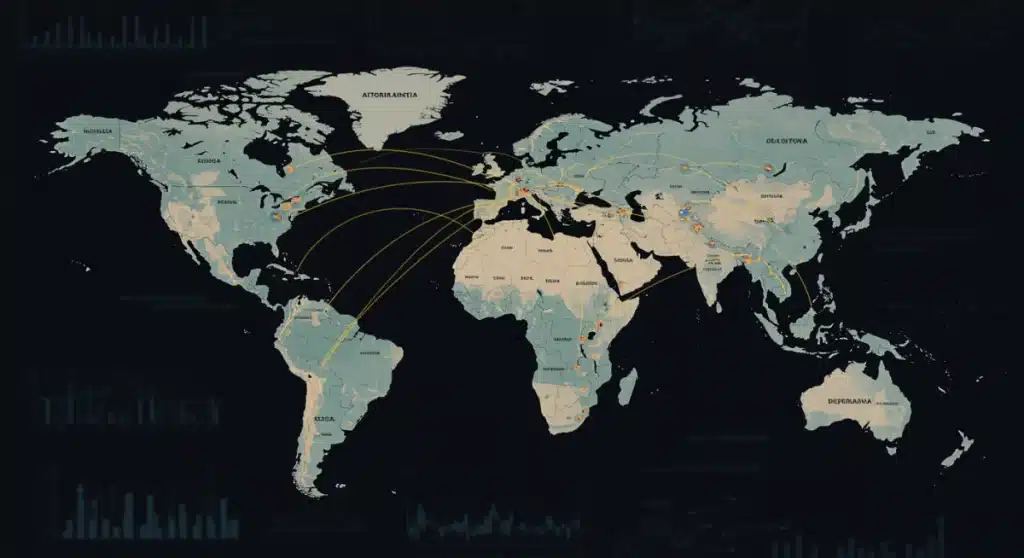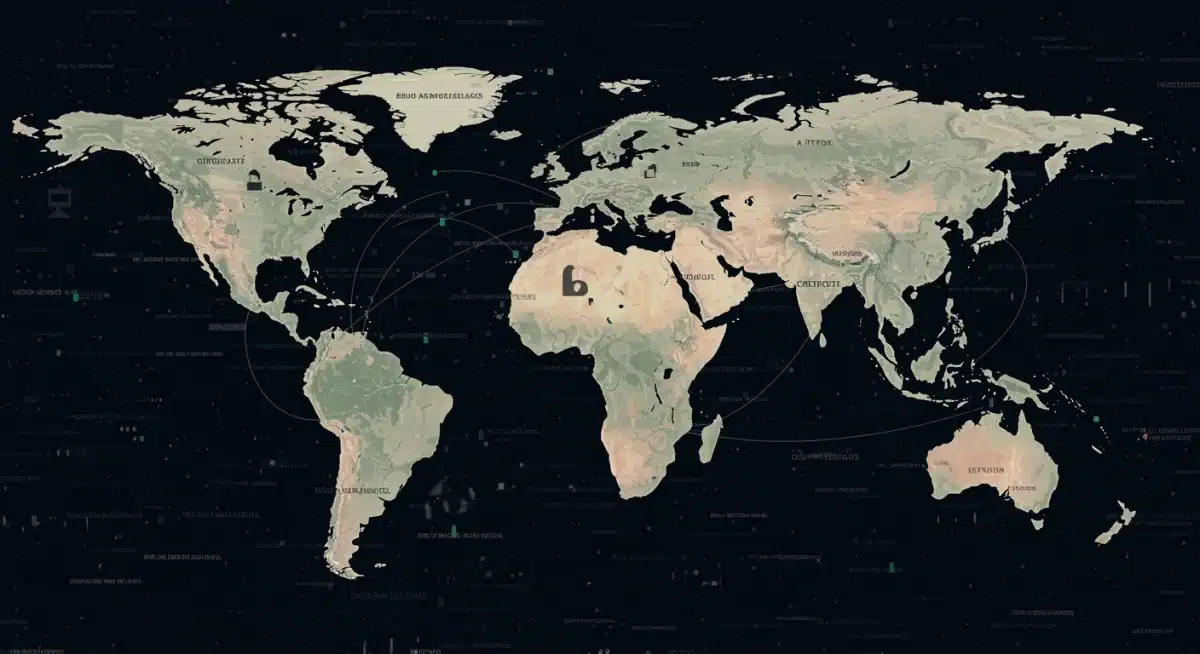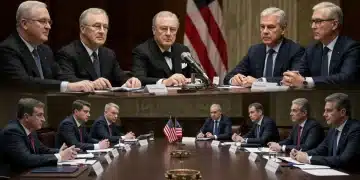Cold War’s Influence on US Foreign Policy in 2025

The Cold War’s enduring legacy profoundly shapes US foreign policy and international relations in 2025, dictating strategic alliances, military postures, and responses to emerging global challenges.
The Cold War’s influence on US foreign policy: How it still shapes international relations in 2025 remains a critical lens through which to understand contemporary global dynamics. Despite decades since its official end, the ideological battles and strategic frameworks forged during this era continue to resonate, impacting decisions made by Washington today.
Understanding the Enduring Bipolar Mindset
The Cold War ingrained a fundamental bipolar mindset within US foreign policy, framing international relations in terms of competition between great powers. This perspective, originally against the Soviet Union, now often reemerges in the context of rising global actors. It fosters a tendency to categorize nations into strategic blocs, influencing diplomatic engagement and resource allocation.
This historical framework dictates how the US perceives threats and opportunities. The emphasis on military deterrence, alliance building, and ideological promotion, all hallmarks of the Cold War, continue to be central tenets. Analysts often point to current US approaches to China and Russia as direct descendants of this ingrained strategic thinking, where rivalry and spheres of influence remain paramount.
Strategic Rivalry and Power Projection
The concept of strategic rivalry, honed during the Cold War, drives significant aspects of US foreign policy in 2025. The focus is often on maintaining a technological edge and projecting power globally to deter adversaries and protect interests.
- Military Modernization: Continuous investment in advanced weaponry and defense systems, often justified by perceived threats from peer competitors.
- Global Basing Strategy: Maintenance of military bases and partnerships worldwide, ensuring rapid deployment capabilities and regional stability.
- Deterrence Posture: A strong emphasis on nuclear and conventional deterrence to dissuade potential aggressors from challenging US interests or allies.
The Reshaping of Alliance Structures
Alliance structures, primarily NATO and various bilateral treaties in Asia, were direct products of the Cold War. In 2025, these alliances are not merely relics but actively adapting to new geopolitical realities, while retaining their foundational anti-hegemonic principles. The US continues to reinforce these partnerships as cornerstones of its foreign policy.
The ongoing adjustments within these alliances demonstrate a blend of historical continuity and contemporary necessity. NATO, for instance, has expanded and refocused on challenges beyond its original scope, including cyber security and emerging technologies, yet its core mission of collective defense against a perceived Eastern threat remains.
NATO’s Evolving Role
NATO, born out of the need to counter Soviet expansion, is currently grappling with renewed security concerns in Europe. Its adaptation reflects a complex interplay of historical mandate and modern security demands.
- Eastern Flank Reinforcement: Increased troop deployments and military exercises in Eastern European member states.
- Cyber Defense Initiatives: Development of robust cyber defense capabilities to counter state-sponsored attacks.
- Partnerships Beyond Europe: Engagement with non-European partners to address global security challenges, indicating a broader strategic outlook.
Ideological Competition in the 21st Century
While the ideological battle of communism versus capitalism defined the Cold War, its modern iteration involves a contest between democratic governance and authoritarian models. The US continues to champion democratic values globally, viewing this as a critical component of its foreign policy and a bulwark against rising authoritarian influences.
This ideological competition manifests in support for democratic movements, sanctions against regimes violating human rights, and efforts to counter disinformation campaigns. The underlying belief is that promoting democratic principles aligns with US national interests by fostering stable, predictable international partners and undermining revisionist powers.
Proxy Conflicts and Regional Instability
The Cold War was characterized by numerous proxy conflicts, where superpowers supported opposing sides in regional disputes without direct confrontation. In 2025, while the direct ideological lines may be blurred, the pattern of great powers indirectly supporting factions in unstable regions persists. This often exacerbates local conflicts and prolongs humanitarian crises.
From resource-rich areas to strategically vital maritime routes, these proxy dynamics reflect ongoing competition for influence and control. The US, alongside other major powers, often finds itself navigating these complex scenarios, trying to balance its interests with the imperative of regional stability and human security.
The reverberations of Cold War-era interventions continue to destabilize some regions. Historical alliances and grievances, often fueled by past superpower involvement, contribute to current tensions. Understanding these historical roots is crucial for effective diplomatic engagement and conflict resolution in the present day.
The Arms Race and Nuclear Proliferation Concerns
The nuclear arms race was a defining feature of the Cold War, creating a precarious balance of terror. In 2025, although the immediate threat of a full-scale nuclear exchange between superpowers has receded, concerns about nuclear proliferation and the modernization of arsenals remain central to US foreign policy. The development of new weapon technologies further complicates this landscape.
Non-proliferation treaties and arms control agreements, many of which originated during the Cold War, are under constant strain. Nations seeking to develop nuclear capabilities challenge the established order, prompting robust diplomatic and sometimes coercive responses from the US and its allies. This ongoing struggle reflects the enduring legacy of nuclear deterrence.

Modernizing Strategic Capabilities
The US military is actively modernizing its strategic capabilities, including nuclear forces, to maintain deterrence in a multipolar world. This involves significant investment in research and development.
- Hypersonic Weaponry: Pursuit of advanced hypersonic missiles to counter similar developments by rival nations.
- Space-based Assets: Expansion of military capabilities in space for communication, surveillance, and potentially defense.
- Cyber Warfare Readiness: Strengthening offensive and defensive cyber capabilities to protect critical infrastructure and project power in the digital domain.
Economic Competition and Global Supply Chains
Economic competition was always an underlying current of the Cold War, but in 2025, it has moved to the forefront of US foreign policy. The race for technological dominance, control over critical supply chains, and access to key markets is now a primary battleground. This economic dimension often intertwines with national security concerns.
The US strategy involves strengthening its domestic industrial base, forming economic alliances, and imposing restrictions on competitors to safeguard its technological edge. This approach mirrors Cold War efforts to contain the economic influence of adversaries, albeit with different tools and a more globally integrated economy.
The emphasis on resilient supply chains, particularly for semiconductors and rare earth minerals, directly reflects lessons learned from past vulnerabilities and current geopolitical tensions. The goal is to reduce dependency on potential adversaries and ensure national security in an increasingly interconnected world.
| Key Aspect | Current Impact in 2025 |
|---|---|
| Bipolar Mindset | Shapes US perception of global rivals and strategic blocs, influencing diplomatic and military strategies. |
| Alliance Structures | NATO and Asian treaties adapt to new threats while retaining core collective defense principles. |
| Ideological Competition | Contest between democratic and authoritarian models drives US support for human rights and democratic movements. |
| Economic Rivalry | Competition for technological dominance and control over critical global supply chains is a key battleground. |
Frequently Asked Questions About Cold War’s Enduring Influence
The Cold War’s emphasis on military superiority and deterrence continues to drive significant US defense budgets. Modernization efforts and strategic investments in advanced weaponry are often justified by perceived threats from peer competitors, echoing the arms race dynamics of the Cold War era.
Yes, Cold War-era alliances like NATO remain highly relevant. They have adapted to new security challenges, such as cyber warfare and hybrid threats, while maintaining their foundational role in collective defense and deterring aggression from potential adversaries, particularly in Europe and Asia.
While communism vs. capitalism defined the Cold War, today’s ideological competition often centers on democratic governance versus authoritarianism. The US continues to promote democratic values, human rights, and open societies as a counter to rising authoritarian influences globally, shaping diplomatic and economic policies.
While direct ideological proxy wars are less common, the US and other major powers still indirectly support various factions in regional conflicts. This can exacerbate instability, as seen in certain Middle Eastern or African regions, reflecting a continued competition for influence without direct confrontation.
Nuclear weapons remain a cornerstone of US deterrence policy, directly inherited from the Cold War. Concerns about proliferation and the modernization of arsenals by other nations continue to shape arms control efforts and strategic dialogues, ensuring that nuclear stability remains a critical foreign policy objective.
What This Means
The persistent shadow of the Cold War ensures that The Cold War’s Influence on US Foreign Policy: How It Still Shapes International Relations in 2025 is not just historical analysis but a live, evolving narrative. The current geopolitical landscape, marked by renewed great power competition, technological rivalry, and ideological clashes, is a direct testament to the enduring frameworks established decades ago. Understanding these foundational elements is crucial for anticipating future policy directions and navigating the complexities of global affairs. Washington’s responses to emerging crises and alliances will continue to bear the imprint of a conflict that officially ended, but whose strategic principles never truly faded.





